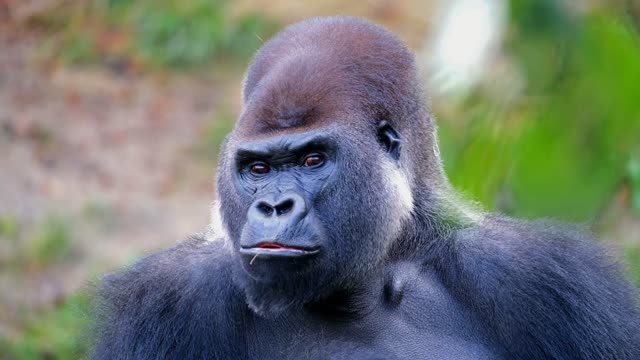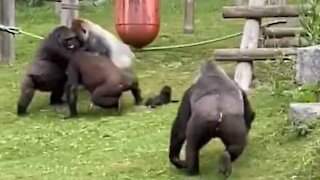Premium Only Content

The incredible, the gorilla who eats like a man.
Gorilla: where it lives, what it eats, characteristics and curiosities
The gorilla belongs to the order of primates and to the family of pongids, also known as "anthropomorphic apes" by virtue of the relatively close relationship that binds them to humans. The chimpanzee also belongs to this group, also widespread in Africa and second, for intelligence, only to man, and the orangutan, great ape of the Sunda islands and very well adapted, unlike its two African cousins, to the life on trees.
Giant African monkey, superior in size and any other species and with an exceptionally robust structure. Adult males usually reach a height of 1.80 m and a weight of just under two quintals. The thorax is powerful, the neck is massive and the arms are very long and muscular, the head is stocky, the skull is surmounted in males by a bony crest, on which the muscles responsible for chewing are inserted.
The teeth are also very robust: the canines, very developed, are as large as those of lions and tigers. The skin is of a black color, while the color of the leather can vary depending on the race and age: in young females and males it is blackish or brown, while in adult males it becomes silvery gray on the back.
Gorillas live exclusively in forests. The two existing species of gorilla live in fact on the African continent, in the forests of the Congo. To inhabit the approximately one thousand square meters of equatorial forest we find two different species of gorilla, the western gorilla and the eastern gorilla.
In its natural habitat it can live up to 50 years, which unfortunately is less and less common due to the damage caused by man. Their distribution area is not very extensive: the most widespread breed, the lowland gorilla is found only in a restricted area of Nigeria, in Cameroon and Gabon, while the rare mountain gorilla lives exclusively in a limited mountainous region of 'Uganda.
The remarkable rarity of the gorillas (which are considered in danger of extinction) is also due to their low prolificacy: each female gives birth every 3 or 4 years (after a gestation of about 10 months) employing this interval of time to take care of them scrupulously care for the only child. Once grown, however, the young gorillas are immediately hunted from the group, to end up having a solitary life or to join other specimens to form a new group.
Gorillas live gathered in groups (like giraffes) headed by a single adult male and composed of females with their young and young of both sexes, for a total, on average, of about twenty individuals.
All the group's activity is decided by the leader, who guides all the movements in search of food. The gorilla's diet mainly includes leaves, stems, roots, trees and plants. Some fruit is also allowed, although it can sometimes eat ants or termites.
-
 0:10
0:10
Innovafilms
4 years ago $0.03 earnedIncredible storm
439 -
 0:10
0:10
marco92
4 years ago $0.01 earnedBaby gorilla
109 -
 0:06
0:06
Rupert4545
4 years agoGorilla at the zoo
81 -
 0:33
0:33
Buri0416_raccoon
4 years agoRaccoon eats feed like humans
1011 -
 2:31
2:31
ViralHog
4 years ago $0.20 earnedIncredible Encounter with an Octopus
9772 -
 0:15
0:15
Peace Of Cake
4 years ago $0.01 earnedIncredible Christmas Cake Pops
99 -
 0:35
0:35
Carispoon
4 years ago $0.01 earnedCute hamster eats food like a vacuum
1411 -
 0:24
0:24
Mormino
4 years ago $0.01 earnedIncredible Stingray Migration!
134 -
 53:49
53:49
thenationalpulse
4 years agoINCREDIBLE: Arizona Hearings
9911 -
 0:46
0:46
Buzzvideos - EN
4 years agoGorilla rescues baby gorilla from fight
10.4K